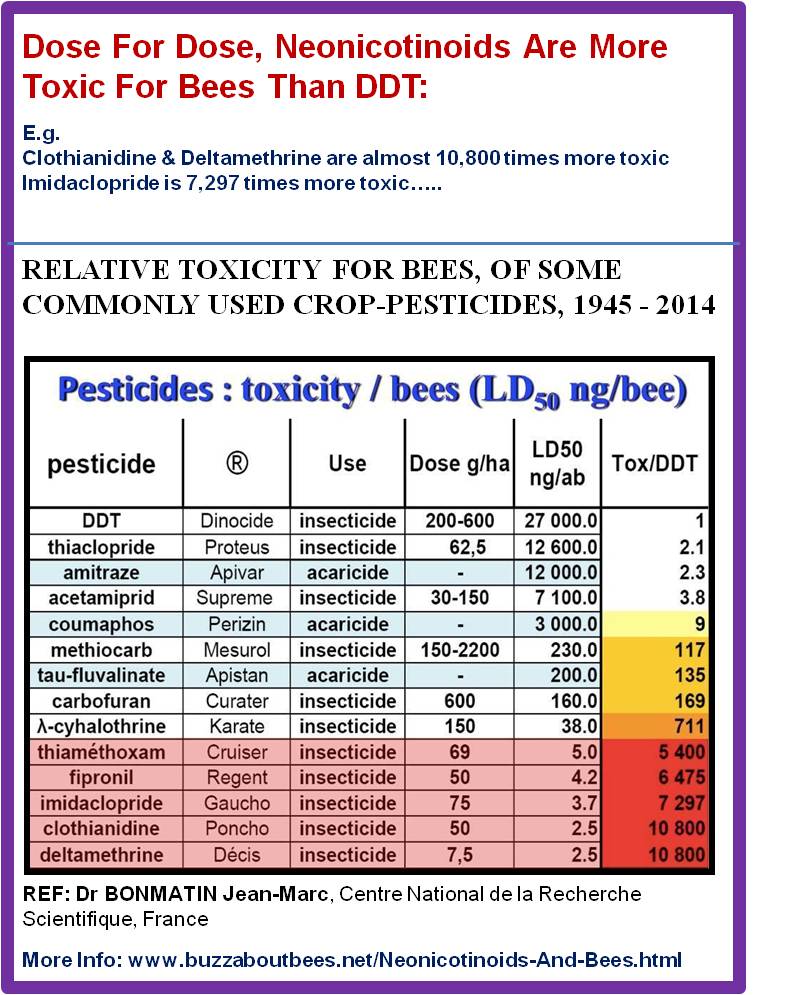Honey Bee Deaths and Pesticides
There is some controversy about honey bee deaths, and whether they are linked to a group of pesticides known as neonicotinoids. Neonicotinoid pesticides include:
- Imidacloprid,
- Acetimacloprid,
- Clothianidin,
- Thiacloprid,
- Thiamethoxam,
- Dinotefuran and
- Nitenpyram.
There is also Fipronil, a systemic pesticide, which works in a very similar way to neonicotinoids.
How Do Neonicotinoid Pesticides Work?
Neonicotinoids are neurotoxins that act on information processing (and hence ability to function or perform tasks), by affecting a specific neural pathway common in invertebrates. In other words, the nervous system is attacked.
Treated insects may exhibit leg tremors, rapid wing
motion, disoriented movement, paralysis and ultimately death.
These pesticides are systemic in that they permeate the whole plant,
being dispersed into plant tissues. This means that insects sucking on
the plant will ingest the pesticide and may suffer some of or all of
the effects described above.
In other words, neonicotinoids create a toxic plant, thereby killing insects which feed on them.
Where Are Neonicotinoids Used?
To an extent, it depends on the country where sold. However:
- They are used in seed dressings, as root drenches and soil treatments for agricultural crops (such as Poncho®, Gaucho®, Merit®).
- In home and garden pesticides, for use by the general public
(such as in some Provado® and Ultimate Bug Killer® products).
- As termite treatment.
- As a lawn treatments (such as Bayer Advanced Lawn Care products) for use, in
gardens, on golf courses and may be used in public amenity areas.
- Neonicotinoids have also been sold in compost products to kill vine weevils, and may be used in horticulture.
- They may be used in pet products as flea treatments.
- Neonicotinoid pesticides are also sometimes used in GM crops such as
Smartstax Corn, which is treated with Clothianidin, a neonicotinoid, rendering the claim that GM crops resulting in less pesticide use by farmers as disingenuos, I think. Farmers not having to appply pesticide themselves does not mean less pesticide is used if they are already incorporated into the crop as a prophylactic measure!
(Source: I-SIS: “SmartStax Corn: Corporate War on Bees”).
- Finally, neonicotinoids may also be used in some wood preservatives and animal flea treatments.
The table below indicates level of toxicity to bees of various neonicotinoids, in comparison with DDT. You can read more about this DDT.
What Do Manufacturers Say?
In Europe, they defend their products with regard to bees, typically stating that they do not pose 'unacceptable risk'. The word 'unacceptable' arguably provides 'wriggle room' for manufacturers.
Nevertheless, their own literature is revealing. To read an example see how do neonicotinoids work.
Do Neonicotinoids Cause CCD?
The term 'CCD' is
complex, and not clear cut. It appears to have been used originally to define a set of symptoms, but
there are variations of definitions and symptoms described. Read more
about
CCD.
The term CCD first appeared in 2006, following a dramatic rise
in the number of disappearances in honey bee colonies in North America.
Literally tens of thousands of bees were disappearing from hives each
day, with some beekeepers reporting losses of 50% of their hives.
Yet the phenomenon of honey bee deaths and disappearance in such a dramatic manner certainly began sooner than 2006, in Europe.
Is Varroa the real cause of colony collapse?
There is significant debate about the factors involved, including neonicotinoid pesticides. For example, Varroa mites may or may not be present.
In France, where dramatic honeybee losses were observed, and honey production dropped from 40,000 to 25,000 tons between the years 1995-2001, it was noted that these events occurred after the neonicotinoid called imidacloprid was applied as a seed dressing to sunflower crops.
Varroa had already been present in France for some years - actually since 1982, yet beekeepers had not witnessed such collapses until after neonicotinoids were introduced on the market.
If you found this page helpful or interesting, I'd really be grateful if you would share it with others - if not this page, perhaps another, such as Gardening For Bees.
Thank you so much :) .
